
Sign up to save your library
With an OverDrive account, you can save your favorite libraries for at-a-glance information about availability. Find out more about OverDrive accounts.
Find this title in Libby, the library reading app by OverDrive.



Search for a digital library with this title
Title found at these libraries:
| Library Name | Distance |
|---|---|
| Loading... |
This book addresses the history and beliefs of the Messianic Jewish Community. When we refer to the Messianic Jewish Community in both ancient and modern contexts, we are discussing a sect whose members identified as Jews who believed in Jesus Christ as the Messiah of Israel while still living within the framework of Judaism. A group of these Jews existed during the first four centuries AD, then vanished before reemerging in the nineteenth century. The purpose of this book is to explore that history up to the present day.
Messianic Judaism (יהדות משיחית) represents a Jewish form of traditional Christianity and a Christian form of Judaism that challenges the boundaries and beliefs of both. Evangelical Protestantism serves as the fertile ground from which the Modern Messianic Jewish Movement has emerged. However, no Jewish group acknowledges the legitimacy of this movement, and the Jewish establishment largely views it as a fraudulent endeavor that promotes the Christian gospel. Some Christians also reject this movement, accusing its followers of Judaization.
It is widely recognized that Messianic Judaism thrived as a vibrant movement for approximately 300 years following the death of Jesus Christ, but it faded away after the First Council of Nicaea in 325 AD. The Jewish rituals present in contemporary Messianic Judaism are regarded as matters of national tradition, personal choice, or missionary tactics among Jews, rather than as theological imperatives.
As the gospel spread across the globe, the number of non-Jewish Christians (Gentile Christians) grew, but the customs and traditions of the apostles were unfamiliar to them, leading them to seek adaptations that aligned with their own cultural preferences. Following the failure of the Bar Kokhba (בר כוכבא) revolution, most Messianic Jews (היהודים המשיחים) were assimilated, either into various Jewish sects or into the ranks of non-Jewish Christians. Consequently, the Jewish identity of the Messianic Community gradually diminished and took on a new character. This transformation occurred towards the end of the third century AD.
Jesus Christ was a Jew, and his first church was Jewish; however, the contemporary church diverged from its Jewish roots after the Gospel spread among surrounding peoples, taking on a global identity and distancing itself from its Jewish origins. Evidence of this shift can be found in the writings of Irenaeus and Epiphanius. Over the years, Messianic Jews became marginalized and were even labeled as heretics by the nations that embraced Pauline Christianity (נצרות פאולינית / Gentile Christianity ). They were ostracized by both Jews and Christians, and within a short time, they vanished from the historical record. From that point until the nineteenth century, it was challenging to find an organized Messianic Jewish community.
O wonder of wonders! The Messianic Jewish Church in the first century graciously accepted Gentile converts without requiring them to adopt a Jewish lifestyle, and two hundred years later, the Gentile Church condemned Jews and demanded that Jewish converts abandon their Jewish lifestyle and become Gentiles. Early Messianics were compelled to take positions in the countries where they lived, and they had to distinguish between true laws and regulations and those that contradicted their doctrine.
Most Messianics overlook the period between the death of John the...







